Free Nations: French
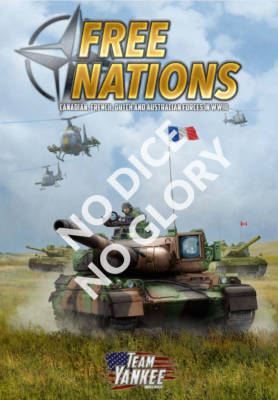 By NDNG_Dane and Christian Caron
By NDNG_Dane and Christian Caron
History of the Free French in Germany by NDNG_Dane
Upon the defeat of Nazi Germany during World War II, the victorious Allies asserted their joint authority over Germany. The four major allied powers divided Germany into four occupation zones, creating what became collectively known as “Allied-occupied Germany”. This division was ratified at the Potsdam Conference (17 July – 2 August 1945).
The French zone of occupation, Troupes d’Occupation en Allemagne, was in the south-west of Germany, closest to the French border. The zone was defined as the southwest Länder of Württemberg, Baden, the Pfalz, and the Saar. Subsequently, on August 10, 1949. The French military forces stationed in Germany were renamed as Forces Françaises en Allemagne (FFA) with a new Headquarters in Baden-Baden.
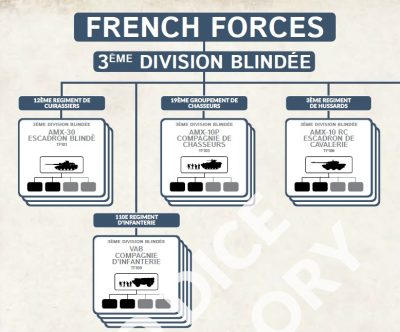
Major shakeup in NATO
In a shocking move against NATO, the French withdrew from “The integrated military command of NATO”. On February 21, 1966, French President, Charles de Gaulle announced that all French forces in Germany and all French personnel assigned to Allied commands would be withdrawn from NATO Allied command on July 1, 1966. NATO allied forces, and specifically Headquarters (SHAPE), were directed to vacate French territory not later than April 1, 1967.
Additionally, President de Gaulle directed that all U.S., UK and Canadian installations on French soil to be closed or, their commands transferred to France by the same date. President De Gaulle did, however, make it clear that France was not withdrawing from NATO entirely…just from the NATO integrated military command. President de Gaulle confirmed that France would continue to abide by treaty obligations and continue to participate in the political aspects of NATO.
Even though the declaration shocked free nations around the world, NATO military planners had known of France’s desire to be in charge of all NATO forces, or not participate. Indeed, NATO’s planners familiar with France’s participation in the WWII D-Day invasion in Normandy reflected how little President de Gaulle’s position had changed from General de Gaulle’s position in during WWII, in that, he wanted to be in charge of the allied invasion of France, or would not support it.
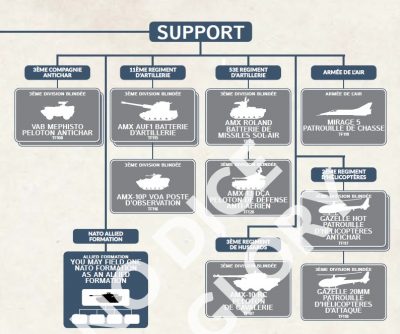 The NATO alliance did suffer some political costs as a result of the French withdrawal. The political balance within the NATO alliance was altered. Additionally, at a time when America was just getting involved in Indochina, following the French withdrawal from Indochina and the French defeat at Dien Bien Phu, American leadership was also asked to do more for NATO.
The NATO alliance did suffer some political costs as a result of the French withdrawal. The political balance within the NATO alliance was altered. Additionally, at a time when America was just getting involved in Indochina, following the French withdrawal from Indochina and the French defeat at Dien Bien Phu, American leadership was also asked to do more for NATO.
NATO planners calculated, despite de Gaulle’s decree to the contrary, that the NATO allies could no longer rely on French troops joining any future battle for the defense of Europe. NATO planners also had to develop new plans for delivering reinforcements and supplies to Europe without the use of French seaports and airports.
In January 1969, NATO tested these new logistical and transportation challenges with a massive Return of Forces to Germany (REFORGER) exercise. Using airports in Germany and seaports in Holland and Germany, The US deployed 12,000 soldiers to Germany and manned pre-positioned equipment to occupy defensive battle positions. Likewise, Forces from the UK and Canada participated in REFORGER as well.
In keeping with the Potsdam Conference agreement to keep forces in Allied-occupied Germany, France maintained three Armored Divisions, forward deployed in Germany as part of the Forces Françaises en Allemagne. Those divisions were:
The 1st Division Blindée was Headquartered in Trier,
The 3rd Division Blindée was Headquartered in Freiburg,
The 5th Division Blindée was Headquartered in Landau.
In Free Nations, these forces are represented by 3rd Division Blindée.
L’armée de Terre Française, ‘honneur et patrie’
by Lt Col. Christian Caron
I have been expecting this book and the arrival of the French with much anticipation. This army is unique by the nature of its equipment that is indigenous, and not widespread within the key NATO factions currently available.
As a result of the French MBT lag, the French forces would have had to rely more heavily on anti-tank guided missiles, such as the Milan and HOT which, although very effective, were not purchased in sufficiently large quantities for a prolonged conventional war. Furthermore, the most modern equipment tended to be concentrated in the forward-deployed II Corps, with I and III Corps having to make do with older equipment.
The French doctrine of the 1980s
The French divisions were composed of task-organized combined arms regiments (essentially large battalions) which mixed tank and mechanized infantry companies on a permanent basis.
The French doctrine saw these divisions operating on rather wide frontages, with uncovered flanks if necessary, and seeking to outflank the enemy rather than engage him frontally. Head-on engagements were eschewed except as a way to fix the enemy for an enveloping manoeuver, and fighting in built-up or wooded areas was similarly to be avoided due to the low infantry strength of French units and the advantages the artillery-heavy Soviet Army would have in such grinding attritional battles.
In Team Yankee, the French Army can field 4 types of formations:
Escadron Blinde (AMX 30 Tank Squadron).
By the mid-1980s tanks like the US M1 Abrams, the German Leopard 2 or the Soviet T64 and T72 were much faster and far better protected. Although the French Tank Squadron varied in size over time from four platoons of 3, 4 or 5 tanks for a total of 13, 17 or 21 tanks respectively, it appears that the Team Yankee Squadron was made based on the four platoons of 4 tanks plus HQ, for a total of 17, which is accurately portrayed. The Free Nation book also gives you the option to field platoons of only 3 tanks.
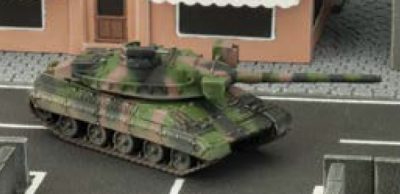 Although it is an aging design by the 1980s, the AMX 30B underwent significant upgrades in the 1970s, and 1980s, which are not fairly represented in the game. It is also a very fragile tank (Front 11, Side 4), which will not stop Warsaw rounds. Note, this vehicle has no anti-HEAT protection!
Although it is an aging design by the 1980s, the AMX 30B underwent significant upgrades in the 1970s, and 1980s, which are not fairly represented in the game. It is also a very fragile tank (Front 11, Side 4), which will not stop Warsaw rounds. Note, this vehicle has no anti-HEAT protection!
However, the AMX 30B2 comes in at 10 pts per platoon of 4 tanks or 42 pts for a Squadron of 17 tanks. This is cheaper than the M60, and Leopard 1. AT-19 gun, range 40 inches means use this like an up-armoured BMP-1 shooting from range and cover. It also comes with additional bonuses: it has a brutal gun (2+), can direct-fire smoke and has an anti-helicopter gun; the 20mm coaxial gun (ROF 3 and 2, AT 6, FP 5+) which can be elevated and depressed separately from the main gun!
Field them in numbers and use cover to mitigate the lack of armour. The large numbers will make even the soviet player hesitate!
The Cavalerie Squadron
The reconnaissance (reco/recon) squadron of AMX-10RC is full of character with its 6 wheels light armour vehicle towered by a giant turret. This formation point cost would be at 28 pts include HQ, so it will have to be combined with other formations or the great support options.
This is a fun option to possibly augment an infantry formation since it would provide you with a total of 12 AMX-10RC equipped with a similar gun as the one fitted on the AMX 30B2, providing you with a brutal gun (AT19, FP2+, HEAT) that can lay smoke. Did I mention it is a reconnaissance (Scout) vehicle? Spearhead is the word!
This formation has a lot of firepower but is extremely fragile due to its armour value (Front 2, Side 1). The AMX-10RC mounted AAMG will be a plus against any enemy air support.
French Infantry (10P Chasseurs or VAB Infantry)
French infantry formations comes in two flavours, the AMX-10P Chasseurs Company and the VAB Infantry Company. The Chasseurs are mechanized infantry which comes in the tracked AMX-10P, while the VAB Infantry comes equipped with a BTR-like 4 wheeled vehicle.
The infantry formations are well-lead by a core of professional officers and NCO: Courage 2+, Morale 4+, Rally 3+, Skill 2+, Assault 4+ and Counterattack of 3+.
Both Infantry formations are identical in terms of composition. Platoons are available in two sizes of 5 or 3 FAMAS sections. Both Platoon size come with short-range anti-tank weapons, 89mm LRAC (AT17, FP4+) and 4 or 3 vehicles accordingly. Both type of infantry can upgrade their 89mm LRAC for a APILAS (AT21, FP3+) for 1 pts and can add 2 Milan teams (AT21, FP3+) for 2 pts for the Chasseurs and 1 pt for the VAB Infantry. Beware, if the HQ is not around, they have a morale of 5+ They are basically ‘Reluctant Veterans’ that un-pin a bit more easily!
Both the AMX-10P and VAB have front armour values of 2 while the former has a side value of 1 and the latter a value of 2. The AMX-10P option will cost you 7 pts for four vehicles and 4 pts for three vehicles. It is equipped with a potent 20mm gun that can hunt helicopters. The VAB, while it has a smaller 12.7mm AAMG, is slightly more expensive at 8 and 6 pts value for the corresponding number of vehicles. Both have the special MILAN MOUNT rule; May remove Milan missile teams before the game, mounting them on a transport team for each team removed.
Support
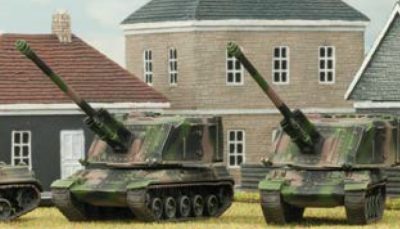 The French, like most NATO nations, can take an allied formation, but I have not looked at it and I frankly will not spare any points on this option. The French formations and support offer so much diversity and bring a breath of fresh air to the Allies who all seem to field Leopard 2s and Gepards…and soon the ADATS!
The French, like most NATO nations, can take an allied formation, but I have not looked at it and I frankly will not spare any points on this option. The French formations and support offer so much diversity and bring a breath of fresh air to the Allies who all seem to field Leopard 2s and Gepards…and soon the ADATS!
The artillery uses the AMX AUF1, a SPG155mm howitzer introduced in 1979. This SPG comes with an autoloader, providing the ability to lay down quick devastating barrages. This special rule means that it reduces the score to hit teams under the template by 1. On the other hand, this guns does not get access to specialty rounds like the US counterpart, and low direct fire AT15. This flaw means that it will not be able to defend itself against marauding tanks. Then again, if tanks are that close, you probably have other problems! 3+ Skill makes Ranging In a lot easier than for other nations. The OP is a must at the low cost of 1 pt. It comes with an additional AMX-10P with an AA MG. It appears the plastic AMX-30 kit can make the AUF1 as well, so with judicious use of Magnets, you could probably be able to swap upper hulls.
The Milan antitank section is a great asset. It provides the needed antitank (AT21) to all formations, specifically the Tank and Cavalerie formations. You can only field one section at the cost of 11 pts for 8 Milan, 8 pts for 6, and 5 pts for 4. This comes with VAB transport vehicles at the ratio of 1 vehicle per 2 Milan teams.
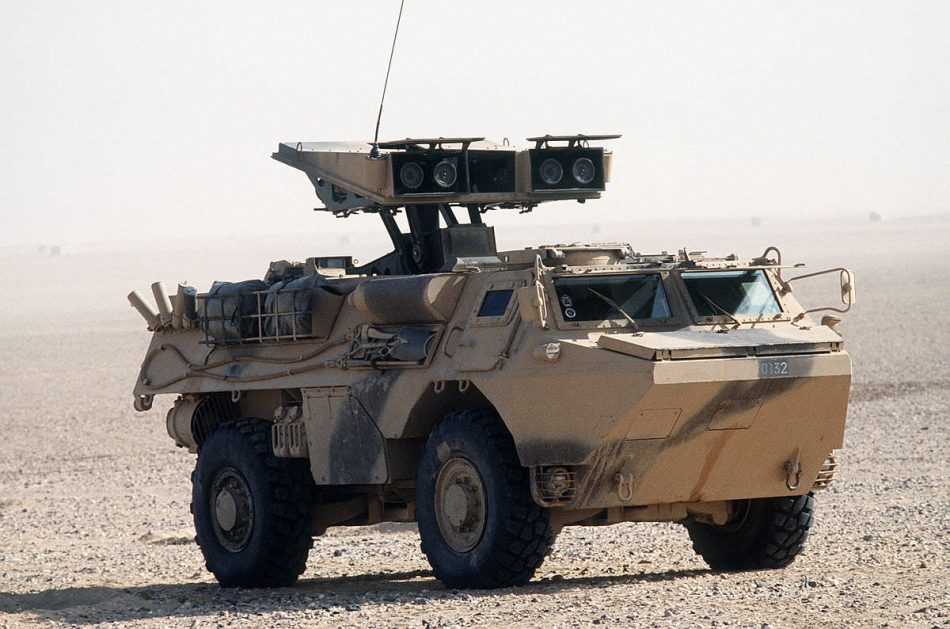 If the Milan antitank section was useful, the Mephisto antitank platoon is an essential addition to any list. You get up to 4 VAB equipped with the mighty HOT missile (AT23, FP3+). A platoon of 4 will cost you 8 pts, while a reduced platoon of 2 Mephisto will cost you 4pts. The hot has a great range of 48”, but it has a minimum range of 8” and can only shoot when stationary. On the positive side, it benefits from the Hammerhead special rule; It can remain concealed behind cover while shooting. It remains Gone to Ground while shooting HOT missile.
If the Milan antitank section was useful, the Mephisto antitank platoon is an essential addition to any list. You get up to 4 VAB equipped with the mighty HOT missile (AT23, FP3+). A platoon of 4 will cost you 8 pts, while a reduced platoon of 2 Mephisto will cost you 4pts. The hot has a great range of 48”, but it has a minimum range of 8” and can only shoot when stationary. On the positive side, it benefits from the Hammerhead special rule; It can remain concealed behind cover while shooting. It remains Gone to Ground while shooting HOT missile.
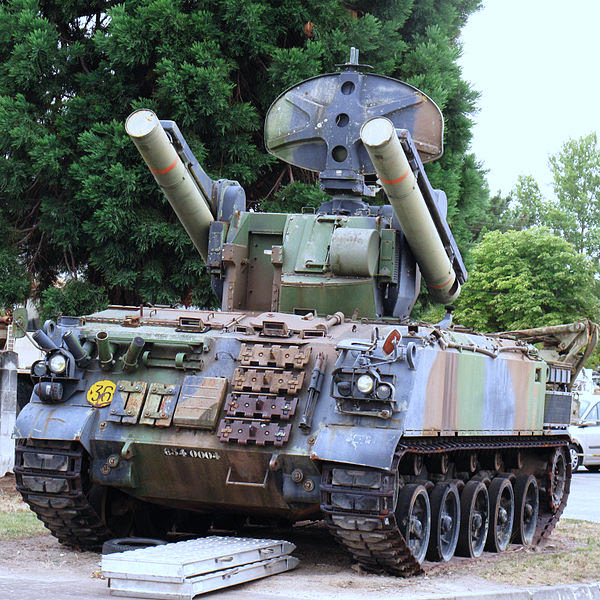
Air defence. Although many of the French unit have either AA MG, Coaxial or Canon that can shoot helicopters and/or fast air, the French army has two very potent systems designated for that role; The AMX Roland and the AMX-13 DCA.
AMX Roland surface to air missile (SAM) provides a great tactical anti-aircraft protection to the armoured divisions. The SAM has a range of 56”, an amazing stationary ROF of 3, and fires a guided AA (FP4+). Four systems will cost 8pts, and 2 Rolands are 4pts.AMX-13 DCA.
The French have their own Gepard…not quite! This dedicated AA platoon can only field 3 vehicles for 4pts. While cheaper, we can only field one platoon and they are not as good as the Gepard. The range is limited to 24”. The ROF is good (5 and 3) and the 30mm is decent (AT7, FP5+). It can be useful against Inf, BMP and BTR when needed. The AMX-13 DCA benefits from the RADAR special rule; Twin guns have a range of 36” against aircraft and does not suffer the +1 to hit penalty for range over 16” when shooting at aircraft.
Rotary wing support. The French have two very different and complementary versions of the Gazelle. The first, Gazelle 20mm, Attack helicopter has a 20mm cannon that plays an anti-helicopter role. The cost of 4 helicopters is 4 pts, while 2 will cost 2pts. This version has the GUNSLINGER special rule; Can use Tall terrain for Concealment and can remain Gone to Ground while moving. Enemy Anti-aircraft, anti-helicopter, and Infantry weapons shoot at it after it shoots in its own turn!
The second, the tank hunter-killer Gazelle is armed with the powerful HOT missile (AT23, FP3+). The pilots fire their missiles from well-concealed ambush. The point value is fairly high at 8 pts for 2 Gazelles and 16 pts for 4 airframes, but Hunter-Killer rule means they can use Tall Terrain and remain Gone to Ground after moving.
Fixed wing
Fast air support is provided through the use of the amazing and unique Mirage 5. This beautiful design can deliver both cluster bombs (AT8, FP3+) or fire its 30mm auto-cannon (ROF3, AT7, FP5+). This marvel of engineering will cost you a grand total of 4 pts for two or 8 pts for four Mirages. The cluster bombs AT-8, Salvo,Skill 3+ is PERFECT for armour that are all clumped together, a fairly common sight on the Team Yankee battlefield!
Also, if you want to proxy some other nation, note that the Mirage 5 was used by air forces such as Belgium, Pakistan, Iraq and as the Nesher ‘Dagger’ and Kfir license-built versions in Israel, and then those were exported to Argentina, Chile, etc!
Conclusion
This faction is sure to be an exciting one by the diversity of the models, the flexibility of the lists and the challenges associated with some of the limitations of its equipment, namely the AMX 30B2. It is clear that a player could choose to mitigate this liability by selecting an Allied formation, likely German or Dutch Leopard 2s, but not me, it will be French all the way with the associated pitfall and downfall!
 I believe a strong infantry formation augmented by a Cavalry squadron or a half tank squadron and supported by the Milan section and/or Mephisto platoon would offer a very difficult proposition for most Warsaw Pact armies and NATO alike. A good force deployment should help mitigate the minimum range of some anti-tank weapon and contribute to success. Of note, this faction is loaded with various anti-helicopter and anti-aircraft options as part of the offered formations, and once you add the Gazelle attack helicopter, the AMX Roland or the AMX-13 DCA, enemy air asset will have to behave.
I believe a strong infantry formation augmented by a Cavalry squadron or a half tank squadron and supported by the Milan section and/or Mephisto platoon would offer a very difficult proposition for most Warsaw Pact armies and NATO alike. A good force deployment should help mitigate the minimum range of some anti-tank weapon and contribute to success. Of note, this faction is loaded with various anti-helicopter and anti-aircraft options as part of the offered formations, and once you add the Gazelle attack helicopter, the AMX Roland or the AMX-13 DCA, enemy air asset will have to behave.
Finally, this list offers the opportunity to play other nations using similar equipment. One could use the French list to proxy the Spanish army who would join NATO in 1986…or slightly earlier if the Cold War went hot. The other NATO nation using the AMX 30B2 and other French equipment is Greece, which would have to play a role in stopping the Red hordes as part of SOUTHAG.

this is easily one of the best articles you guys have ever done! great job!
Thanks I’ll pass it along to Christian.
Love the first photo.